Arduino and Nordic nRF52-DK: debugging and unit testing
The goal of this tutorial is to demonstrate how simple it is to use PlatformIO IDE for VSCode to develop, run and debug a simple project with Arduino framework for Nordic nRF52-DK board.
Level: Beginner
Platforms: Windows, Mac OS X, Linux
Requirements:
Downloaded and installed PlatformIO IDE for VSCode
Install drivers for J-LINK debug tool
Nordic nRF52-DK development board
Setting Up the Project
At first step, we need to create a new project using PlatformIO Home Page (to open this page just press Home icon on the toolbar):
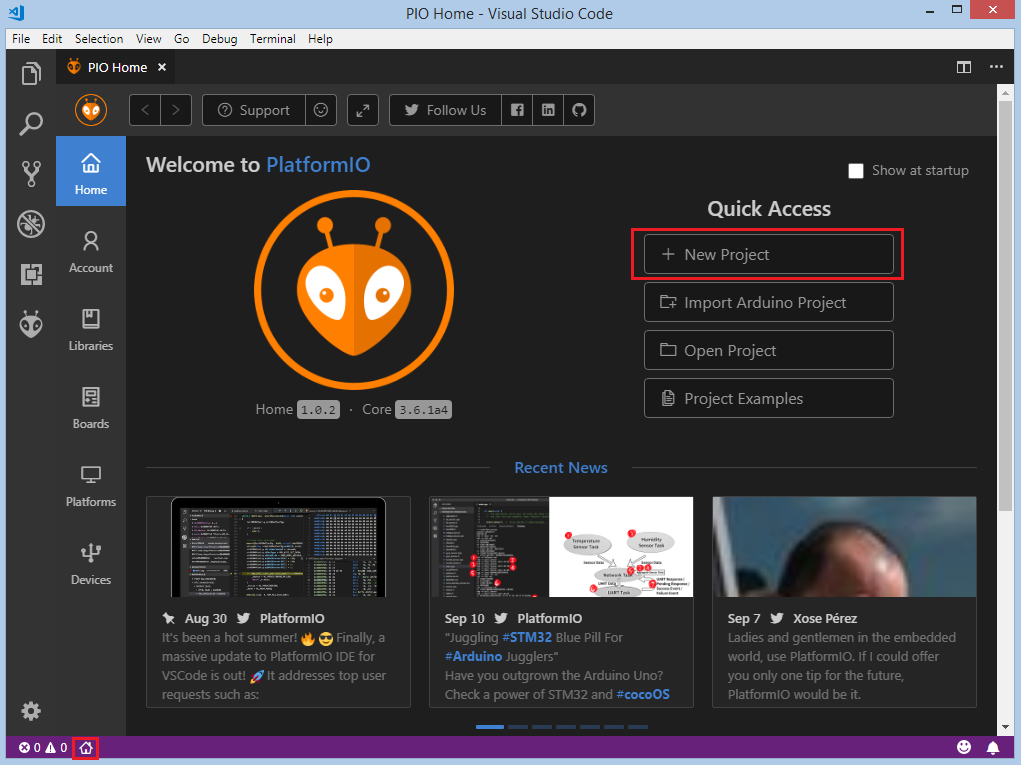
On the next step we need to select Nordic nRF52-DK as a development board, Arduino as a framework and a path to the project location (or use the default one):
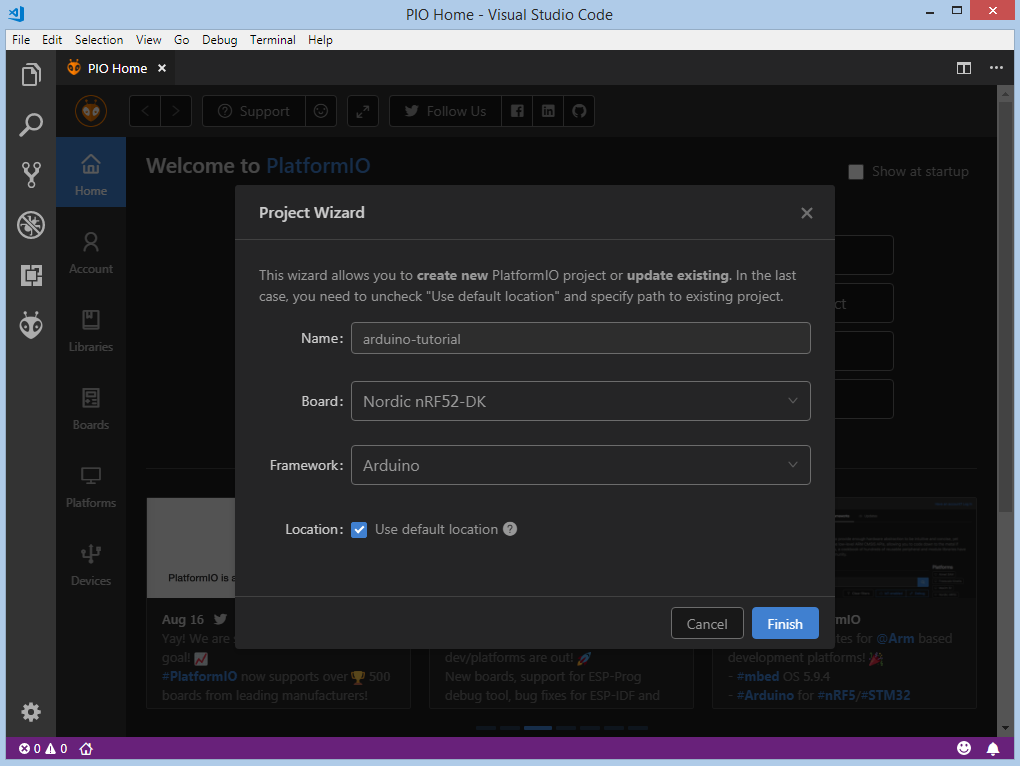
Processing the selected project may take some amount of time (PlatformIO will download and install all required packages) and after these steps, we have a fully configured project that is ready for developing code with Arduino framework.
Adding Code to the Generated Project
Let’s add some actual code to the project. Firstly, we open a default main file main.cpp in the src_dir folder and replace its contents with the following:
#include <Arduino.h>
void setup()
{
pinMode(LED_BUILTIN, OUTPUT);
}
void loop()
{
digitalWrite(LED_BUILTIN, HIGH);
delay(100);
digitalWrite(LED_BUILTIN, LOW);
delay(100);
}
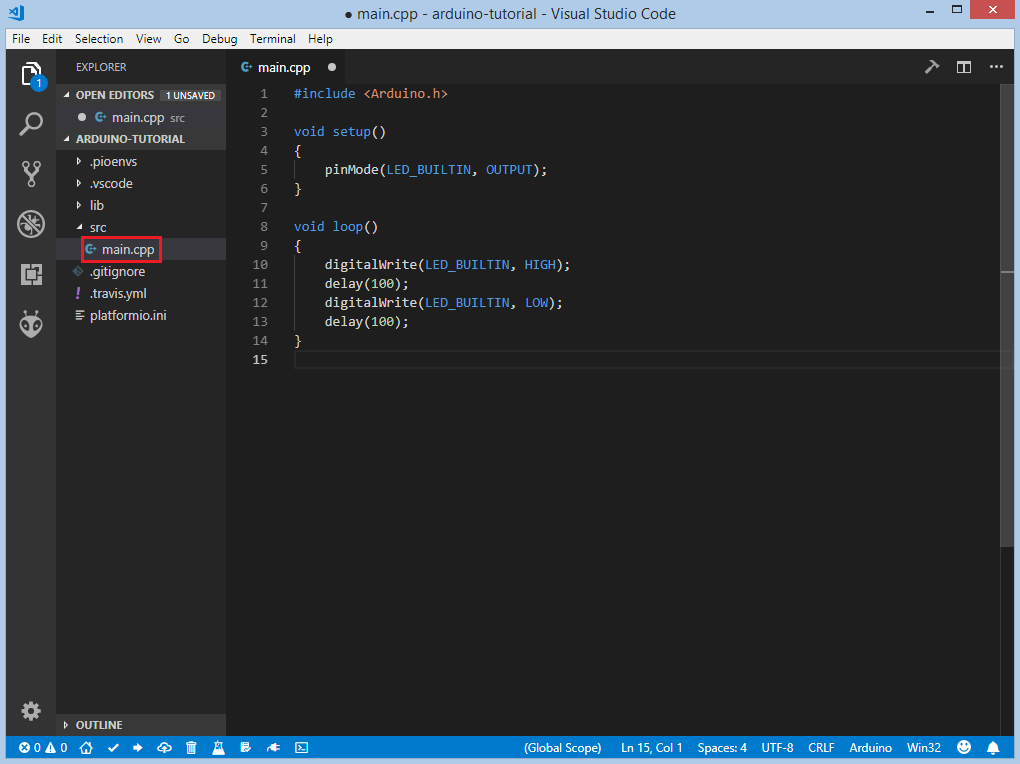
After this step, we created a basic blink project ready for compiling and uploading.
Compiling and Uploading the Firmware
Now we can build the project. To compile firmware we can use next options:
Build option from the Project Tasks menu, Build button in PlatformIO Toolbar, Task Menu Tasks: Run Task... > PlatformIO: Build or in PlatformIO Toolbar, Command Palette View: Command Palette > PlatformIO: Build or via hotkeys cmd-alt-b / ctrl-alt-b:
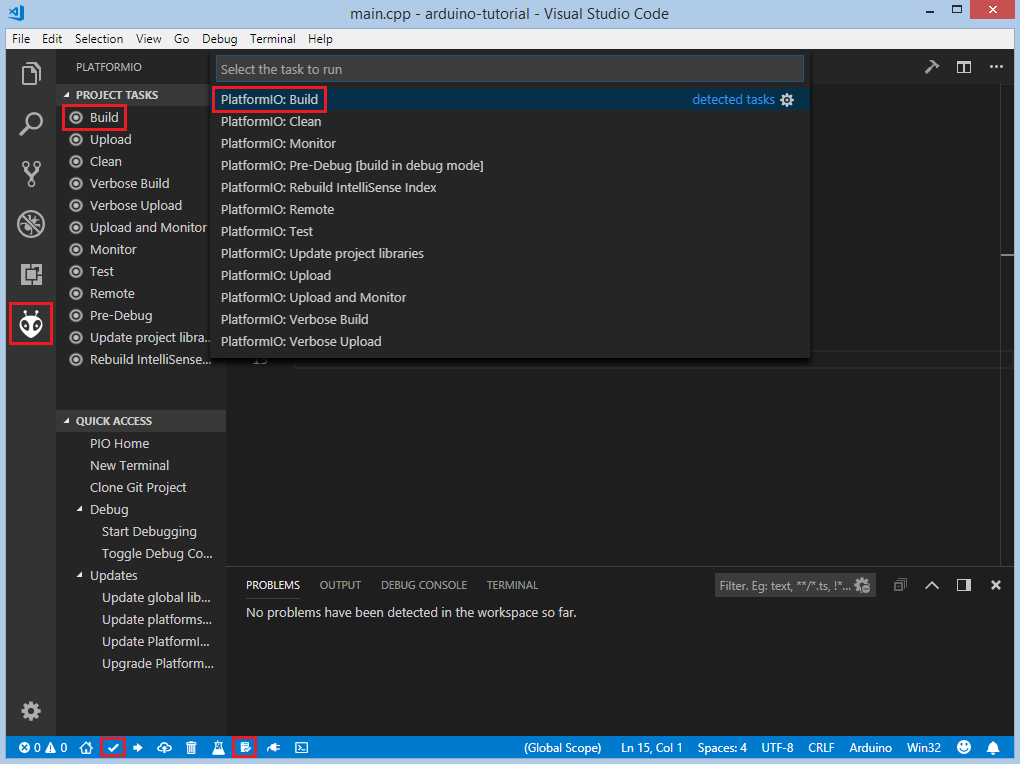
If everything went well, we should see a successful result message in the terminal window:

To upload the firmware to the board we can use next options:
Upload option from the Project Tasks menu, Upload button in PlatformIO Toolbar, Command Palette View: Command Palette > PlatformIO: Upload, using Task Menu Tasks: Run Task... > PlatformIO: Upload or via hotkeys cmd-alt-u / ctrl-alt-u:
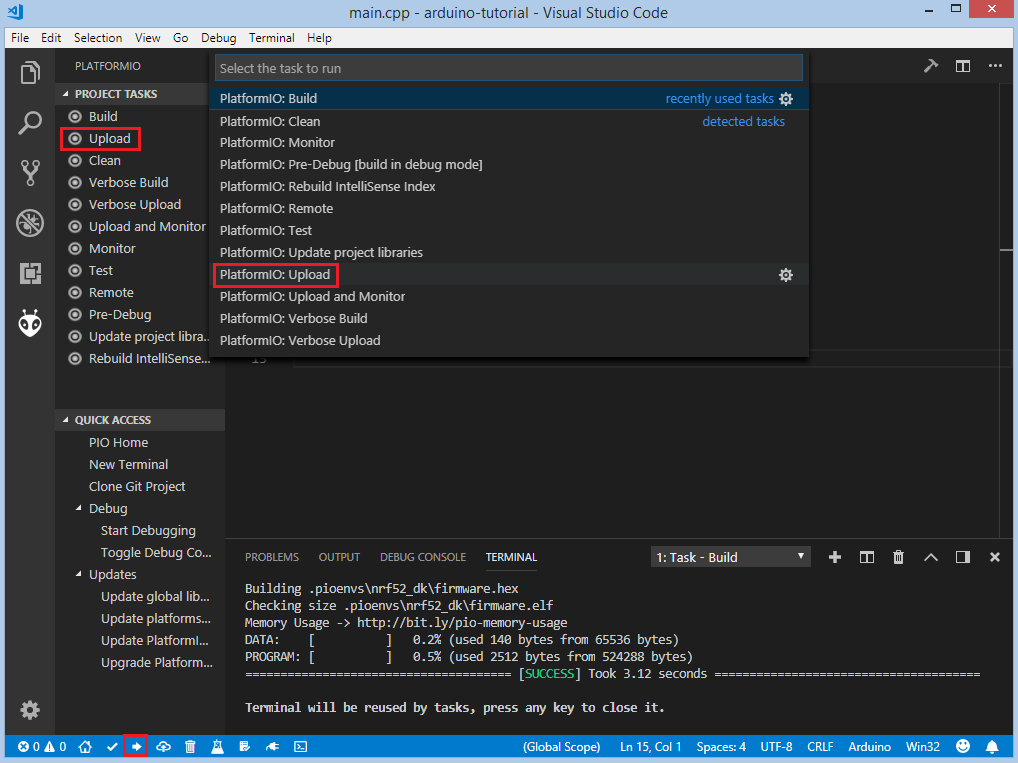
After successful uploading, the green LED1 should start blinking.
Debugging the Firmware
Debugging offers the easiest way to debug the board. Firstly, we need to specify debug_tool in “platformio.ini” (Project Configuration File). Since the board has an on-board JLink debug probe we can directly declare it in “platformio.ini” (Project Configuration File):
[env:nrf52_dk]
platform = nordicnrf52
board = nrf52_dk
framework = arduino
debug_tool = jlink
To start the debug session we can use next options:
Debug: Start debugging from the top menu, Start Debugging option from Quick Access menu or hotkey button F5:
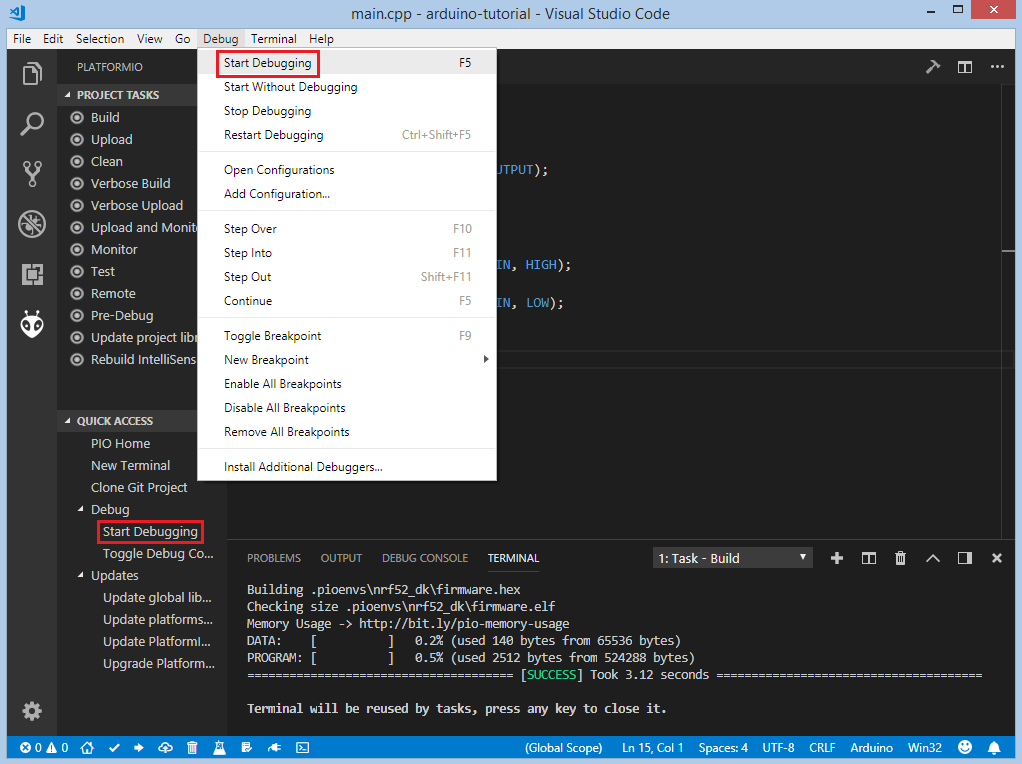
We need to wait some time while PlatformIO is initializing the debug session and when the first line after the main function is highlighted we are ready to debug:
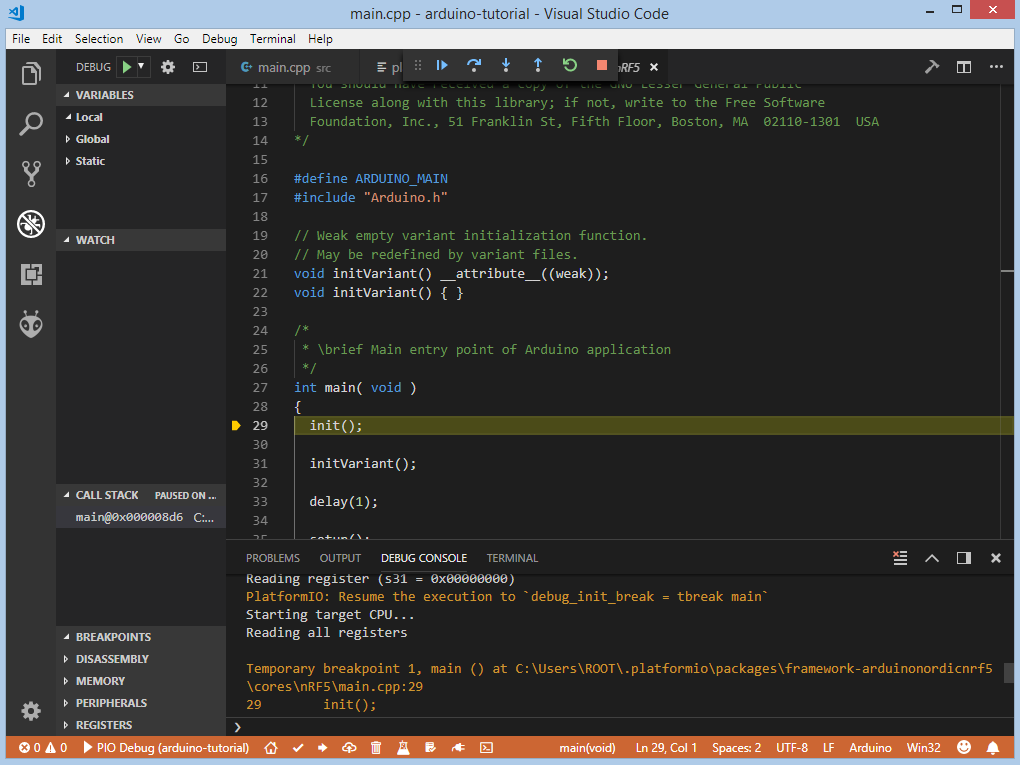
We can walk through the code using control buttons, set breakpoints, add variables to Watch window:
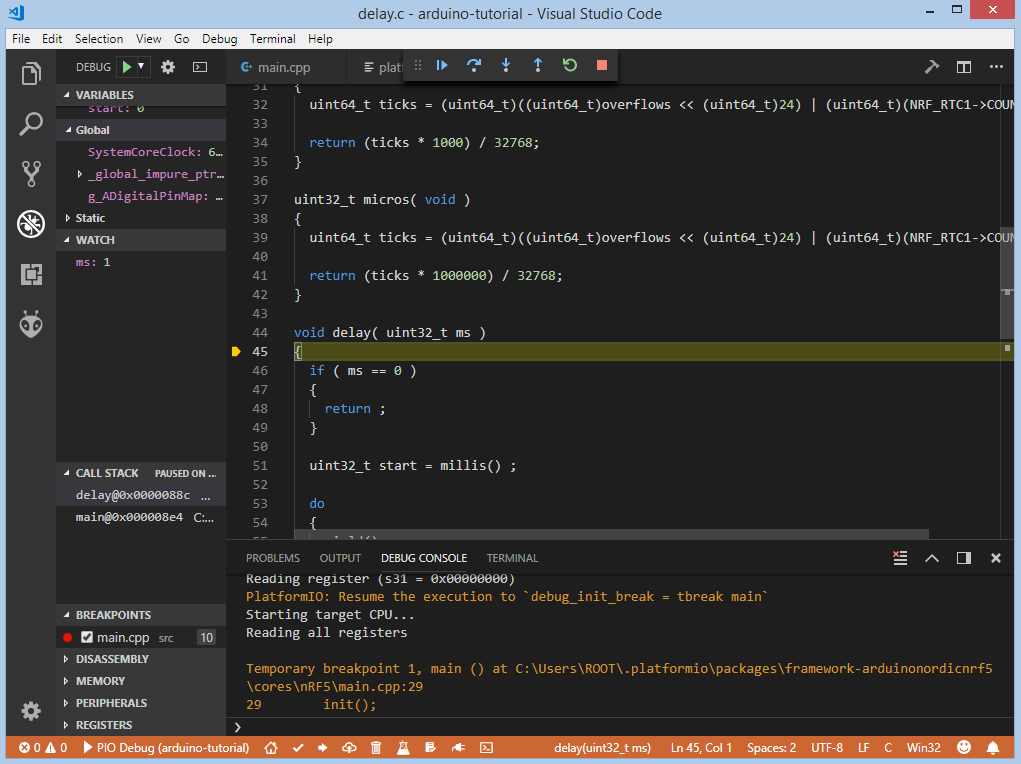
Writing Unit Tests
Unit Testing test cases can be added to a single file that may include multiple tests. First of all, in this file, we need to add four default functions: setUp, tearDown, setup and loop. Functions setUp and tearDown are used to initialize and finalize test conditions. Implementations of these functions are not required for running tests but if you need to initialize some variables before you run a test, you use the setUp function and if you need to clean up variables you use tearDown function. In our example we will use these functions to accordingly initialize and deinitialize LED. setup and loop functions act as a simple Arduino program where we describe our test plan.
Let’s create test folder in the root of the project and add a new file test_main.cpp to this folder. Next basic tests for String class will be implemented in this file:
test_string_concattests the concatenation of two stringstest_string_substringtests the correctness of the substring extractiontest_string_index_ofensures that the string returns the correct index of the specified symboltest_string_equal_ignore_casetests case-insensitive comparison of two stringstest_string_to_upper_casetests upper-case conversion of the stringtest_string_replacetests the correctness of the replacing operation
Note
2 sec delay is required since the board doesn’t support software resetting via
Serial.DTR/RTS
#include <Arduino.h>
#include <unity.h>
String STR_TO_TEST;
void setUp(void)
{
// set stuff up here
STR_TO_TEST = "Hello, world!";
}
void tearDown(void)
{
// clean stuff up here
STR_TO_TEST = "";
}
void test_string_concat(void)
{
String hello = "Hello, ";
String world = "world!";
TEST_ASSERT_EQUAL_STRING(STR_TO_TEST.c_str(), (hello + world).c_str());
}
void test_string_substring(void)
{
TEST_ASSERT_EQUAL_STRING("Hello", STR_TO_TEST.substring(0, 5).c_str());
}
void test_string_index_of(void)
{
TEST_ASSERT_EQUAL(7, STR_TO_TEST.indexOf('w'));
}
void test_string_equal_ignore_case(void)
{
TEST_ASSERT_TRUE(STR_TO_TEST.equalsIgnoreCase("HELLO, WORLD!"));
}
void test_string_to_upper_case(void)
{
STR_TO_TEST.toUpperCase();
TEST_ASSERT_EQUAL_STRING("HELLO, WORLD!", STR_TO_TEST.c_str());
}
void test_string_replace(void)
{
STR_TO_TEST.replace('!', '?');
TEST_ASSERT_EQUAL_STRING("Hello, world?", STR_TO_TEST.c_str());
}
void setup()
{
delay(2000); // service delay
UNITY_BEGIN();
RUN_TEST(test_string_concat);
RUN_TEST(test_string_substring);
RUN_TEST(test_string_index_of);
RUN_TEST(test_string_equal_ignore_case);
RUN_TEST(test_string_to_upper_case);
RUN_TEST(test_string_replace);
UNITY_END(); // stop unit testing
}
void loop()
{
}
Now we are ready to upload tests to the board. To do this we can use next options:
Test button on PlatformIO Toolbar, Test option from the Project Tasks menu or Tasks: Run Task... > PlatformIO Test from the top menu:
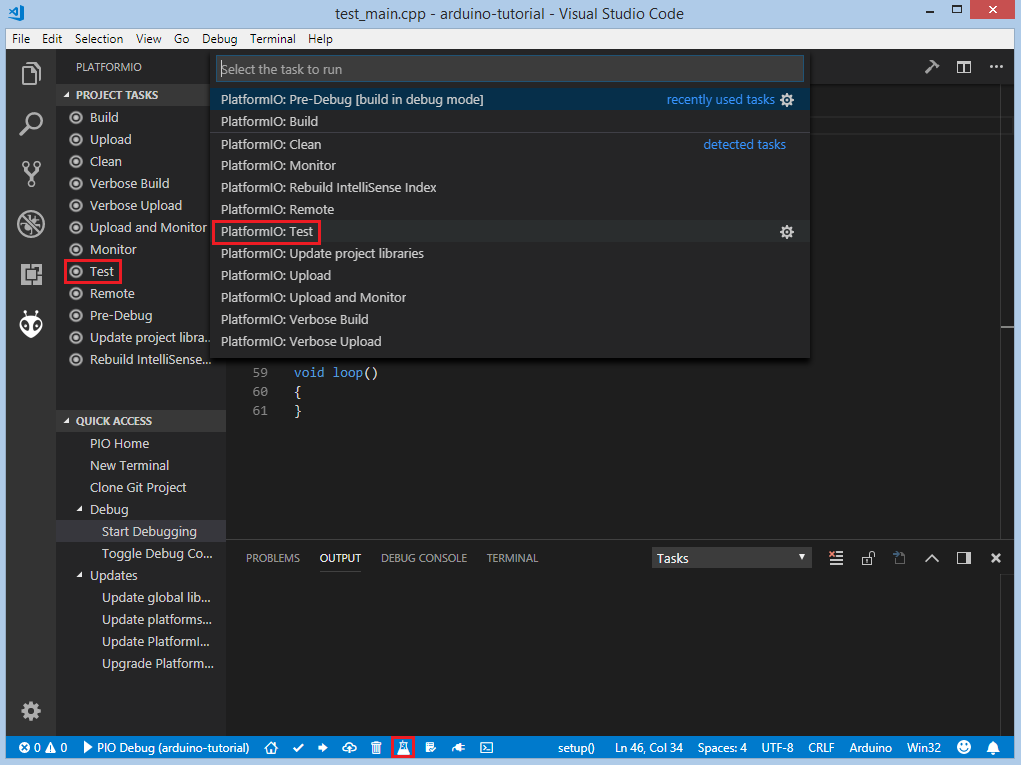
After processing we should see a detailed report about the testing results:
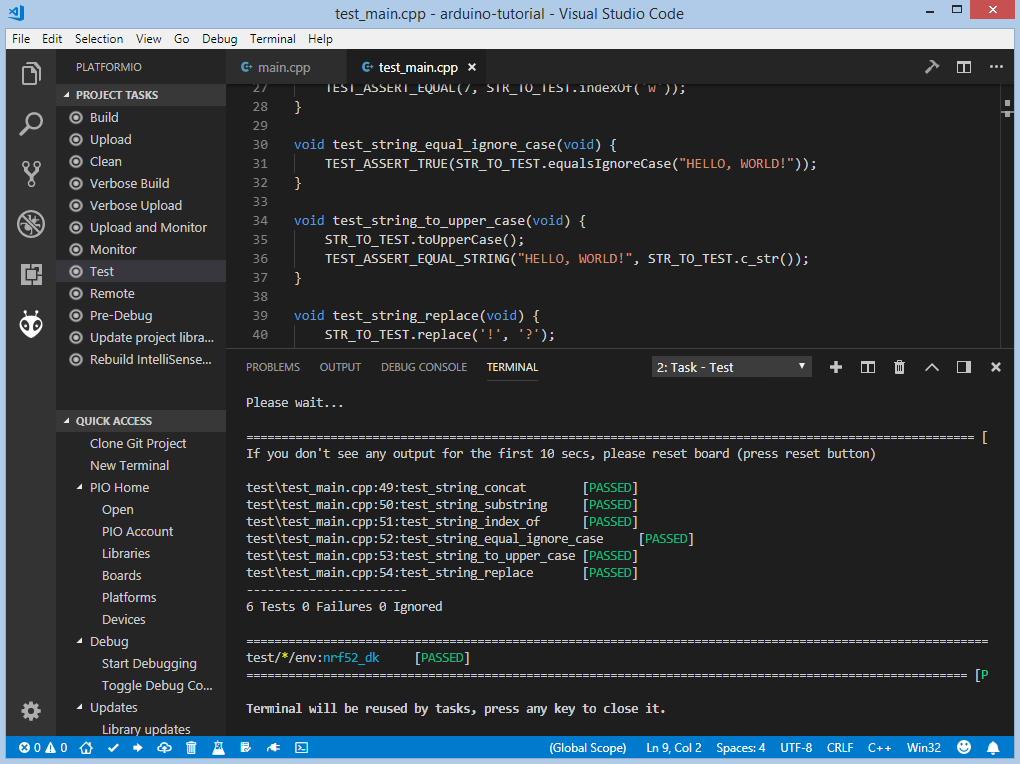
As we can see from the report, all our tests were successful!
Adding Bluetooth LE features
To add the basic BLE functionality to our project we need to define the SoftDevice version and install a library called BLEPeripheral. Both these modifications can be specified in “platformio.ini” (Project Configuration File):
[env:nrf52_dk]
platform = nordicnrf52
board = nrf52_dk
framework = arduino
debug_tool = jlink
; SoftDevice version
build_flags = -DNRF52_S132
lib_deps =
BLEPeripheral
Now let’s create a basic application that can interact with other BLE devices (e.g phone) For example, next code declares a BLE characteristic that controls the state of the LED1.
#include <Arduino.h>
#include <SPI.h>
#include <BLEPeripheral.h>
BLEPeripheral ledPeripheral = BLEPeripheral();
BLEService ledService = BLEService("19b10000e8f2537e4f6cd104768a1214");
BLECharCharacteristic ledCharacteristic = BLECharCharacteristic("19b10001e8f2537e4f6cd104768a1214", BLERead | BLEWrite);
void setup()
{
pinMode(LED_BUILTIN, OUTPUT);
ledPeripheral.setAdvertisedServiceUuid(ledService.uuid());
ledPeripheral.addAttribute(ledService);
ledPeripheral.addAttribute(ledCharacteristic);
ledPeripheral.setLocalName("Nordic NRF52 DK");
ledPeripheral.begin();
}
void loop()
{
BLECentral central = ledPeripheral.central();
if (central)
{
while (central.connected())
{
if (ledCharacteristic.written())
{
if (ledCharacteristic.value())
{
digitalWrite(LED_BUILTIN, HIGH);
}
else
{
digitalWrite(LED_BUILTIN, LOW);
}
}
}
}
}
Now we can compile and upload this program to the board as described in previous sections. To verify that our application works as expected, we can use any Android smartphone with BLE feature and Nordic nRF Connect tool.
At first, we need to scan all advertising BLE devices and connect to the device called Nordic NRF52 DK.
After a successful connection to the board, we should see one “Unknown Service” with one “Unknown Characteristic” fields:
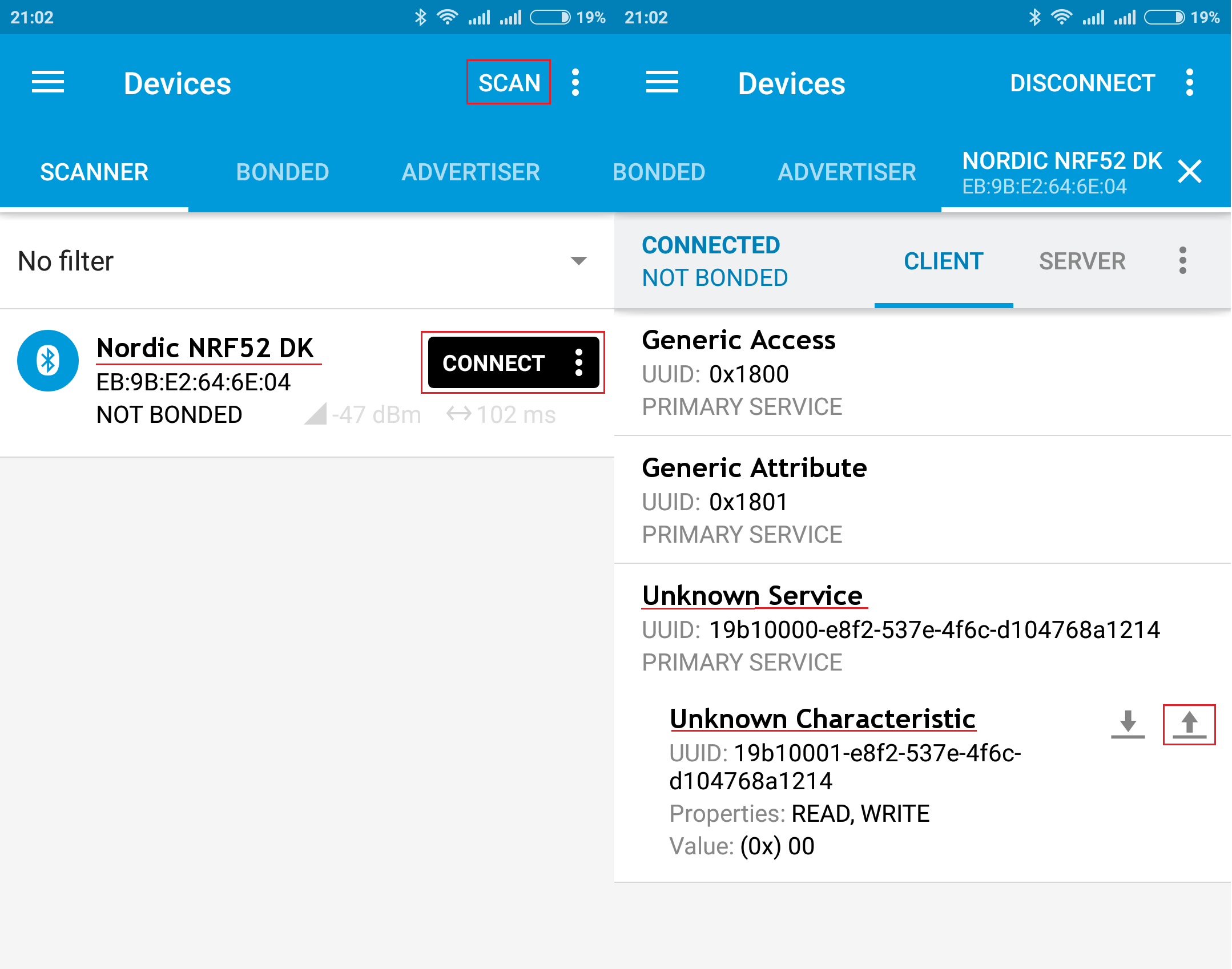
To switch the LED on or off we just need write 0 or 1 as UINT8 to the BLE characteristic:
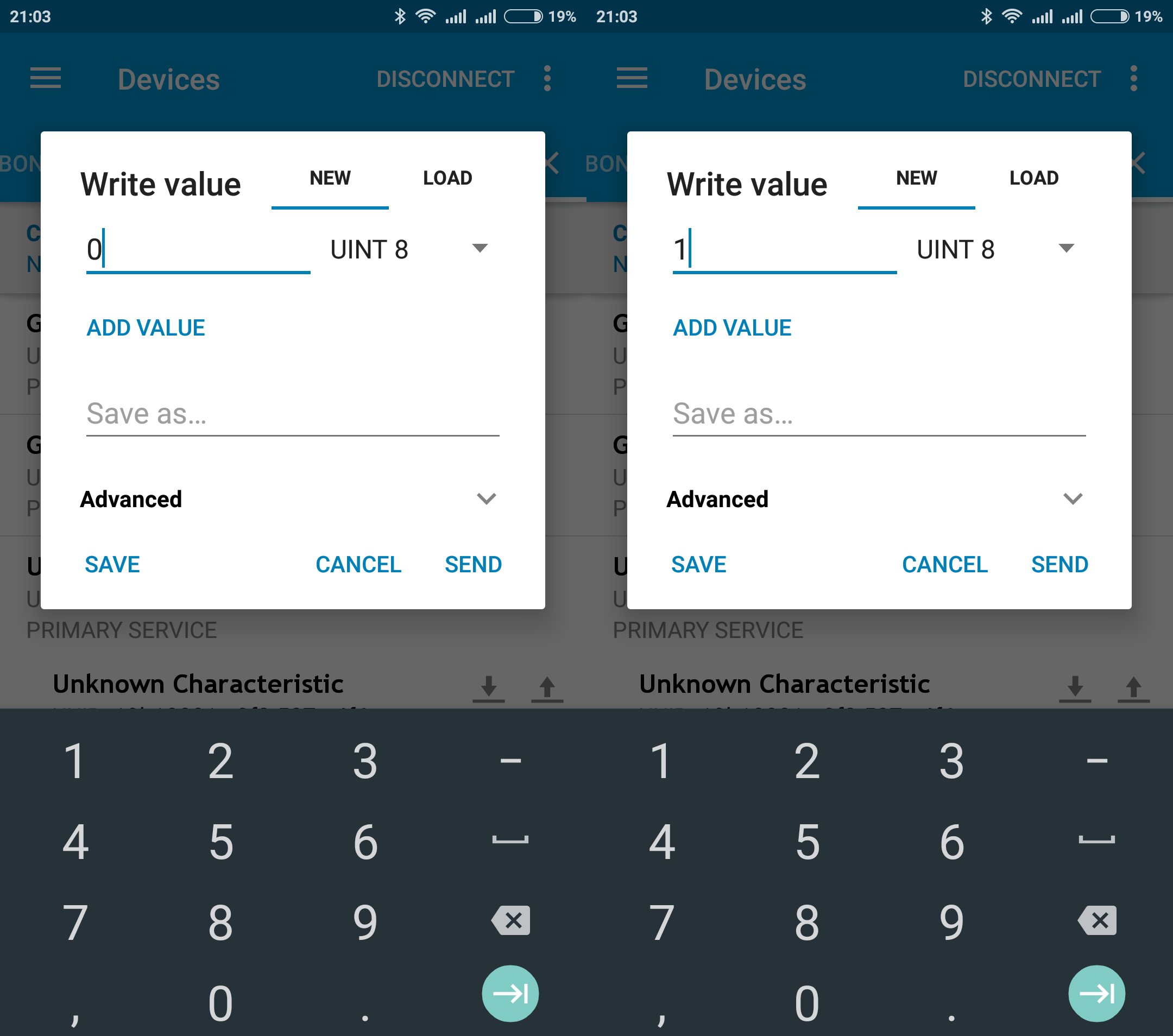
Conclusion
Now we have a project template for Nordic nRF52-DK board that we can use as a boilerplate for the next projects.